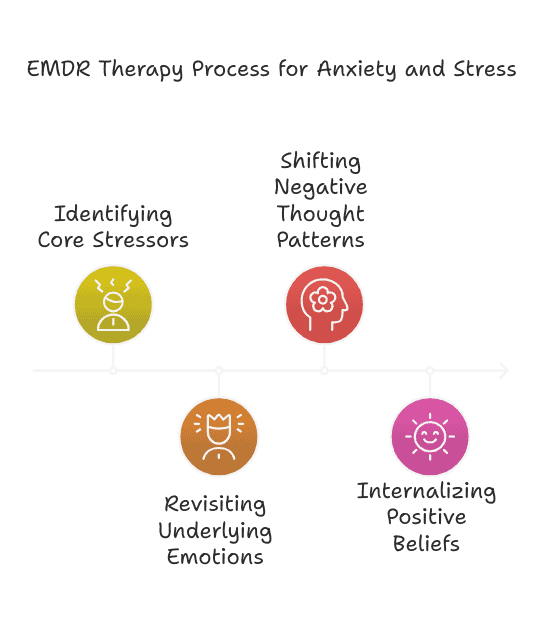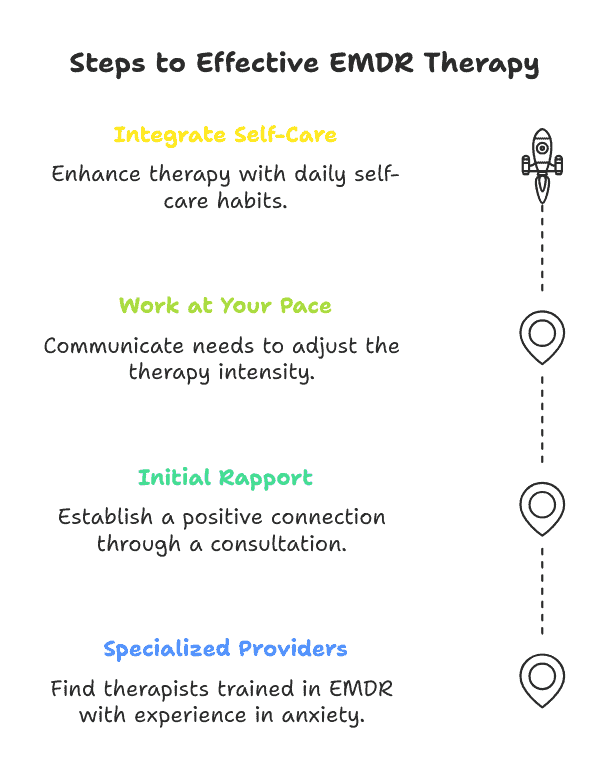
Hello, I’m Gloria Segovia from AERCS Therapy in Toronto and covering the GTA. Navigating anxiety and stress can feel overwhelming, but you don’t have to face it alone. EMDR Therapy offers a highly effective method. Let’s work together in a safe environment to find the right path for your well-being.
Does EMDR Therapy Help with Anxiety and Stress in GTA Professionals?
Life in the Greater Toronto Area (GTA) can be both exciting and demanding. Many professionals find themselves juggling fast-paced careers, intense deadlines, and personal responsibilities—all of which can contribute to significant levels of stress and anxiety.
While EMDR (Eye Movement Desensitization and Reprocessing) therapy is often associated with resolving deep-seated trauma, it’s increasingly recognized as a valuable tool for tackling the accumulated stress and anxiety that working professionals face.
Below, we’ll discuss how EMDR therapy works, why it may be especially helpful for GTA professionals, and how to get started if you’re ready to ease the weight on your shoulders.

Understanding Anxiety and Stress in Professional Settings
The GTA is a hub for various industries—from finance and tech to healthcare and public service. Long commutes, competitive job markets, and high cost of living can intensify everyday pressure. Over time, persistent anxiety and stress can disrupt sleep, hamper concentration, and lead to burnout.
- Physical Strain: Tense muscles, headaches, or frequent illnesses due to chronic stress.
- Emotional Turmoil: Irritability, restlessness, or a constant “on edge” feeling that spills into personal life.
- Productivity Declines: Even motivated professionals can find performance slipping when anxiety becomes overwhelming.
Although mild stress can sometimes fuel productivity, ongoing anxiety is detrimental to both mental and physical health—making effective interventions crucial.
What Is EMDR Therapy?
EMDR therapy helps individuals process troubling experiences and negative thought patterns using bilateral stimulation (often through guided eye movements or gentle tapping).
While it’s traditionally known for assisting people with PTSD and other trauma-related conditions, the underlying mechanism can also help people struggling with entrenched stressors, panic responses, or anxieties linked to challenging life events.
Key Aspects of EMDR That Benefit Professionals
- Targeted Relief: Instead of trying to manage anxiety from the outside in, EMDR uncovers the underlying emotional or psychological “roots” that keep stress cycles active.
- Adaptive Insights: The mind can form healthier responses to triggers—like work deadlines or complex interpersonal dynamics—reducing the intensity of anxious reactions.
- Flexible Format: EMDR protocols can be adapted to accommodate different lifestyles, making it feasible for professionals with tight schedules.
How EMDR Therapy Addresses Anxiety and Stress
- Identifying Core Stressors
Before initiating bilateral stimulation, you and your therapist pinpoint the specific sources of anxiety—perhaps a fear of failure, interpersonal conflicts at work, or worries about job security. Gaining clarity on these triggers lays a strong foundation for EMDR sessions. - Revisiting Underlying Emotions
With the selected area of focus, the therapy encourages reflection on memories, images, or beliefs that exacerbate stress. This process isn’t about endless talk; instead, you briefly connect with the discomfort so your brain can begin to reframe its response. - Shifting Negative Thought Patterns
The bilateral stimulation (eye movement, tapping, or other methods) nudges the brain toward a more integrated view of the identified stressor. Over several sessions, many people report experiencing reduced urgency and calmer responses when faced with the same high-pressure events. - Internalizing Positive Beliefs
Once you’ve lessened the intense anxiety around certain triggers, you can incorporate more constructive, empowering thoughts. For instance, transforming “I’m overwhelmed by my responsibilities” into “I can handle my workload in manageable steps.”
Why GTA Professionals Find EMDR Helpful
- Fast-Paced Environment: When every minute counts, a therapy approach that delivers tangible change can be appealing. EMDR’s focused protocol frequently offers quicker relief compared to some longer-term interventions.
- Versatility: Stress can come from a variety of sources—client expectations, performance reviews, unexpected career shifts. EMDR techniques are flexible enough to tackle a range of anxieties without needing a separate treatment model for each.
- Holistic Support: An EMDR therapist can blend this approach with other supportive strategies (like mindfulness or brief cognitive exercises) to create a well-rounded plan tailored to your goals.
Tips for Getting Started in the GTA
- Look for Specialized Providers
Select a therapist who has completed formal EMDR training and has experience working with anxiety or stress-related challenges. Some therapists specifically cater to busy professionals, offering convenient scheduling or remote sessions. - Prioritize Initial Rapport
Having a positive connection with your therapist is essential. A short consultation—by phone or video—allows you to gauge whether their style suits your comfort level. - Work at Your Own Pace
The intensity of EMDR can vary. If certain aspects of work or personal stress feel overwhelming, communicate that. Therapists often have tools to slow the process or supplement it with additional grounding methods. - Integrate Self-Care
Even the most effective therapy can be enhanced by daily habits—like short walks, consistent bedtimes, or moments of deep breathing during the day. Think of these self-care activities as scaffolding that supports your therapeutic gains.

How AERCS Supports GTA Professionals
At AERCS, we understand the unique pressures high-achieving individuals face. Our EMDR services are designed to help you manage anxiety, reduce stress, and reconnect with a sense of balance. By fostering a comfortable and respectful atmosphere, we ensure each client feels heard and empowered.
Additional Offerings:
- Individualized Sessions: EMDR protocols tailored to professional life stressors.
- Supplementary Techniques: Incorporating mindfulness-based practices or lifestyle tips to maintain emotional equilibrium between sessions.
- Flexible Scheduling: Options to accommodate busy timetables, so getting support doesn’t disrupt your entire week.
Take the First Step Toward Easier Days
Anxiety and stress don’t have to overshadow your professional or personal life in the GTA. EMDR therapy offers a dynamic way to shift your mindset, release burdensome patterns, and regain confidence. Rather than just managing each wave of stress as it comes, consider a deeper approach that can break the cycle at its core.
If you’re ready to explore whether EMDR therapy can assist with your unique concerns, AERCS is here to help. Contact us to discuss your goals, ask questions, or book your first session. Your time is valuable—why not invest it in a proven method that aims to enhance your long-term well-being and peace of mind?
FAQs About EMDR Therapy for Anxiety and Stress in GTA Professionals
What is EMDR therapy, and how does it help with anxiety and stress?
EMDR (Eye Movement Desensitization and Reprocessing) therapy is a specialized approach that helps individuals process unresolved emotions and negative thought patterns related to anxiety and stress. By using bilateral stimulation, EMDR allows the brain to reframe responses to triggers, leading to reduced anxiety and improved emotional well-being.
Can EMDR therapy be effective for professionals dealing with work-related stress?
Yes, EMDR therapy is highly effective for professionals experiencing work-related anxiety and stress. It targets the root causes of stress—such as fear of failure, workplace conflicts, or career pressures—and helps individuals develop healthier responses to these challenges.
How is EMDR different from traditional talk therapy for anxiety and stress?
Unlike traditional talk therapy, EMDR focuses on identifying and processing specific stressors or memories using techniques like eye movements or tapping. This method helps accelerate emotional healing and often delivers noticeable relief from anxiety and stress in fewer sessions.
How long does it take for EMDR to reduce anxiety and stress?
The duration varies based on individual needs, but many professionals notice significant relief from anxiety and stress after just a few EMDR sessions. The therapy’s targeted approach allows it to address deep-seated stressors efficiently.
Is EMDR therapy suitable for busy professionals in the GTA?
Absolutely. EMDR therapy is designed to accommodate professionals’ schedules, offering flexible formats such as in-person or remote sessions. It’s an ideal choice for those managing anxiety and stress in Toronto’s fast-paced environment.
What should I expect during an EMDR session for anxiety and stress?
In an EMDR session, your therapist will guide you to identify specific stressors, revisit emotions tied to them, and use bilateral stimulation to shift your brain’s response. Over time, you’ll internalize more positive beliefs and experience reduced anxiety.

Take the First Step Toward Healing Today
Discover the transformative power of EMDR therapy with Gloria, an experienced and compassionate psychotherapist dedicated to helping you process trauma, reduce anxiety, and reclaim your life.
Fill out the form below to connect directly with Gloria and start your journey toward peace and clarity. Your healing begins here. Don’t wait—complete the form now!











